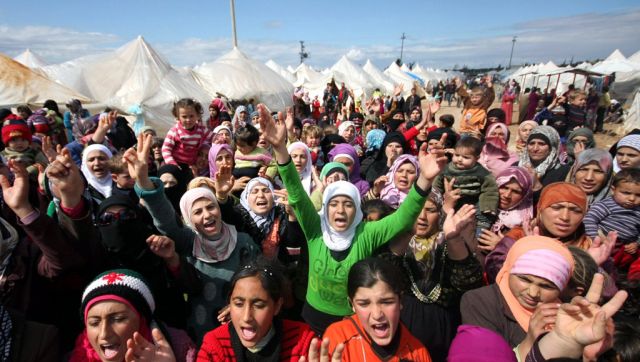VIENNA (APP) – Thousands of migrants streamed into Austria on Saturday after being shunted through Croatia, Hungary and Slovenia, as Europe’s divided nations stepped up efforts to push the wave of desperate humanity on to other neighbours.
Between 12,000 to 13,000 people entered Austria over the course of the day, the head of the Austrian Red Cross, Gerry Foitik, told APA news agency.
The figure was not immediately confirmed by Austrian police, who earlier said they were bracing for an influx of around 10,000 refugees and migrants.
Hungary’s right-wing government, which has faced international criticism over violent clashes with migrants and a hastily erected fence along its frontier with Serbia, has vowed to “defend its borders” against the flood of arrivals, most of whom are from the Middle East and Africa.
But in a shift late Friday, Hungarian authorities began transporting thousands of migrants straight to the border with Austria, an apparent bid to move them through and out of their territory as quickly as possible.
Austrian police said Hungary had bussed at least 6,700 people to the border, with more expected in the Burgenland border region by the end of Saturday.
There was no let-up in the stream of people making the gruelling journey across the Balkans into western Europe, with Croatia saying 20,700 had entered the country since Wednesday.
Croatia, which initially said it would allow migrants to pass through freely, announced it was swamped on Friday and began transporting hundreds to the Hungarian border by bus and train — sparking a furious reaction from Budapest.
Migrants were also being taken to Slovenia, where 1,500 had arrived since Friday, according to the interior ministry.
Unlike Croatia, both Hungary and Slovenia belong to Europe’s passport-free Schengen zone.
“Croatia will not become Europe’s refugee centre,” Prime Minister Zoran Milanovic warned.
In a new hurdle aimed at stemming the influx, Hungary said it had completed a 41-kilometre (25-mile) barbed-wire barrier along part of its frontier with Croatia.
The remaining 330 km of the border runs roughly along the Drava river, which is difficult to cross.
The new barrier adds to a barbed-wire fence that Hungary completed along its frontier with Serbia earlier this week, backed with laws threatening illegal migrants with jail, which forced the migrant flow towards neighbouring Croatia.
On the Croatia-Slovenia frontier, aid tents have sprung up with local and foreign volunteers giving out food, water and clothes.
“It’s generous of them,” said Khaddam Ghaiath, a Syrian former customs official who is on the road with his 70-year-old mother.
“It must be a shock for them to see thousands of people arriving like this. It is not a normal situation.”
Tensions boiled over at the Croatian border town of Harmica overnight, with Slovenian riot police using pepper spray against several hundred migrants, some with children, who had sought to push through their cordon into Slovenia, an AFP photographer saw.
The clash happened shortly after Slovenian Prime Minister Miro Cerar said the small country might consider creating “corridors” for refugees wanting to reach northern Europe if they continue arriving in large numbers.
The premier later on Saturday said the situation was “under control” but he criticised Croatia for directing migrants towards Slovenia, saying the newest member of the EU had not “done its job” in handling the flood of newcomers.
4,500 rescued at sea
Figures released Friday showed the EU received almost a quarter of a million asylum requests in the three months to June, while the International Organization for Migration (IOM) said nearly 474,000 people had so far this year braved perilous trips across the Mediterranean to reach Europe.
Italy’s coastguard on Saturday said it had picked up more than 4,500 people off the Libyan coast, as calm seas sparked a flurry of attempts to make the crossing.
The continent’s biggest migratory flow since the end of World War II has dug a deep rift between western and eastern EU members over how to distribute the migrants fairly.
Another worry is over the fate of the Schengen agreement, a pillar of the European integration project that allows borderless travel between member states.
Germany, Europe’s biggest economy, is the great magnet for the migrants, expecting up to a million asylum seekers this year.
But the country’s Interior Minister Thomas de Maiziere said the EU should in future take a finite number of migrants, while sending the rest back to a safe country in their home regions.
“We cannot accept all the people who are fleeing conflict zones or poverty and want to come to Europe or Germany,” Thomas de Maiziere said in an interview with news weekly Spiegel.
EU interior ministers are to meet again on Tuesday, followed by an emergency summit on Wednesday.
Meanwhile, European leaders called for more action to tackle the problem at one of its sources — Turkey, from where many of the migrants have travelled, including tens of thousands of Syrian refugees.
European Commissioner Johannes Hahn said Saturday the EU was earmarking aid of “up to one billion euros” ($1.13 billion) to encourage Syrian refugees in Turkey to stay there.
And Austrian Chancellor Werner Faymann and German Vice Chancellor Sigmar Gabriel issued a joint call for United Nations countries to contribute an extra five billion euros in aid for refugees living in camps in Lebanon and Jordan.
Of the more than four million Syrians who have fled their country, nearly half have sought shelter in Turkey, while more than a million are now living in Lebanon and at least 600,000 in Jordan.














